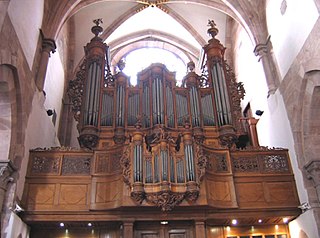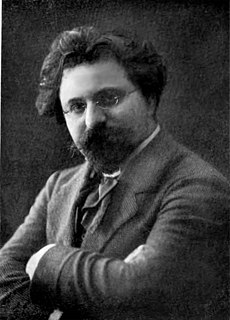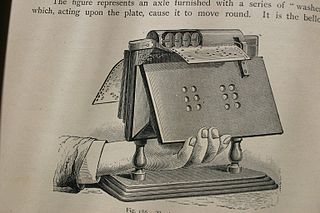
An electronic musical instrument or electrophone is a musical instrument that produces sound using electronic circuitry. Such an instrument sounds by outputting an electrical, electronic or digital audio signal that ultimately is plugged into a power amplifier which drives a loudspeaker, creating the sound heard by the performer and listener.

Sir John Ambrose Fleming FRS was an English electrical engineer and physicist who invented the first thermionic valve or vacuum tube, designed the radio transmitter with which the first transatlantic radio transmission was made, and also established the right-hand rule used in physics.

In music, the organ is a keyboard instrument of one or more pipe divisions or other means for producing tones, each played from its own manual, with the hands, or pedalboard, with the feet.

A free reed aerophone is a musical instrument that produces sound as air flows past a vibrating reed in a frame. Air pressure is typically generated by breath or with a bellows. In the Hornbostel–Sachs system, it is number: 412.13. Free reed instruments are contrasted with non-free or enclosed reed instruments, where the timbre is fully or partially dependent on the shape of the instrument body, Hornbostel–Sachs number: 42.

An electric organ, also known as electronic organ, is an electronic keyboard instrument which was derived from the harmonium, pipe organ and theatre organ. Originally designed to imitate their sound, or orchestral sounds, it has since developed into several types of instruments:

Sigfrid Karg-Elert was a German composer in the early twentieth century, best known for his compositions for pipe organ and reed organ.

Orchestrion is a generic name for a machine that plays music and is designed to sound like an orchestra or band. Orchestrions may be operated by means of a large pinned cylinder or by a music roll and less commonly book music. The sound is usually produced by pipes, though they will be voiced differently from those found in a pipe organ, as well as percussion instruments. Many orchestrions contain a piano as well. At the Musical Museum in Brentford, London England, examples may be seen and heard of several of the instrument types described below.

The pump organ is a type of free-reed organ that generates sound as air flows past a vibrating piece of thin metal in a frame. The piece of metal is called a reed. Specific types of pump organ include the reed organ, harmonium, and melodeon. The idea for the free reed was imported from China through Russia after 1750, and the first Western free-reed instrument was made in 1780 in Denmark.

Chord organ is a kind of home organ that has a single short keyboard and a set of chord buttons, enabling the musician to play a melody or lead with one hand and accompanying chords with the other, like the accordion with a set of chord buttons which was originated from a patent by Cyrill Demian in 1829, etc.
The orchestrina di camera is a small keyboard instrument invented around the 1860s by the English builder of harmoniums and organs, Cheltenham-born W. E. Evans (1810–1884).

Henry Ward Poole (1825–1890) was an American surveyor, civil engineer, educator and writer on and inventor of systems of musical tuning. He was brother of the famous librarian William Frederick Poole, and cousin of the celebrated humorist, journalist and politician Fitch Poole.

Christian Friedrich Ludwig Buschmann was a German musical instrument maker and inventor, often credited with inventing the harmonica and also the accordion.

Finchcocks is an early Georgian manor house in Goudhurst, Kent. For 45 years it housed a large, visitor-friendly museum of historical keyboard instruments, displaying a collection of harpsichords, clavichords, fortepianos, square pianos, organs and other musical instruments. The museum was run by the owners of the house, Richard and Katrina Burnett. It is now owned by Neil and Harriet Nichols who use it as a family home and a venue for residential piano courses.

John Joseph Merlin was a Belgian from the Prince-Bishopric of Liège in the Holy Roman Empire. He was a Freemason, clock-maker, musical-instrument maker, and inventor. He moved to England in 1760. By 1766 he was working with James Cox and creating automatons such as Cox's timepiece and the Silver Swan. By 1773 he was designing and making innovative keyboard instruments. In 1783 he opened Merlin's Mechanical Museum in Princes Street, Hanover Square, London, a meeting-place for the gentry and nobility. In addition to his clocks, musical instruments and automata, Merlin is credited with the invention of inline skates in the 1760s. He was referred to by contemporaries as "The Ingenious Mechanic". He was friendly with composer Joseph Haydn.

Charles King Hall (1845–1895), often credited as King Hall, was an English composer and church organist in Victorian London. He favored sentimental ballads, dance music, organ and piano pieces, and "much church music." He also specialized in arranging for the keyboard and voice the works of famous composers such as Handel, Gounod and Mendelssohn. Active in the London theatre, he contributed regularly to the German Reed Entertainments at St. George's Hall, Langham Place. King Hall's entry in A Biographical Dictionary of Musicians calls his German Reed operettas "his most popular works."

Gulbransen Company was a musical instrument manufacturer of player pianos and home organs in the United States. It also made reed organs. It was originally established in 1904 by Axel Gulbransen as Gulbransen Piano Company.

The Organette was a mechanical free-reed programmable (automatic) musical instrument first manufactured in the late 1870s by several companies such as John McTammany of Cambridge, Massachusetts, the Autophone Company of Ithaca, New York, the Automatic Organ Co of Boston, Massachusetts, E.P. Needham & Sons of New York City, J.M. Draper of Blackburn, England, Paul Ehrlich & Co. of Leipzig, Germany, and The Mechanical Orguinette Co. of New York, NY as well as other manufacturers worldwide.

Music technology is the study or the use of any device, mechanism, machine or tool by a musician or composer to make or perform music; to compose, notate, playback or record songs or pieces; or to analyze or edit music.
The aeolodion or aeolodicon is an obsolete keyed wind instrument resembling the harmonium, its tone being produced from steel springs. It had a range of six octaves, and its tone was similar to that of the harmonium. After its invention around 1800, several modifications were made, including the aeolsklavier, aeolomelodicon or choraleon, and aeolopantalon, but all versions had largely disappeared by mid-century.
Cleveland Thomas Johnson is an American academic, administrator, music historian, and early-music performer. He retired as President/CEO of the Morris Museum in 2022. Previously, he was Director of the National Music Museum, Executive Director of the Thomas J. Watson Fellowship, Dean of the School of Music at DePauw University, Professor of Music at DePauw University (1985-2012), and Music Librarian at Old Dominion University. DePauw University awarded him the title, Professor Emeritus of Music, in 2012.
![Seraphine (c. 1840)
a collection of MET [89.4.1779]. Seraphine MET 225316.jpg](http://upload.wikimedia.org/wikipedia/commons/thumb/6/6a/Seraphine_MET_225316.jpg/220px-Seraphine_MET_225316.jpg)
















